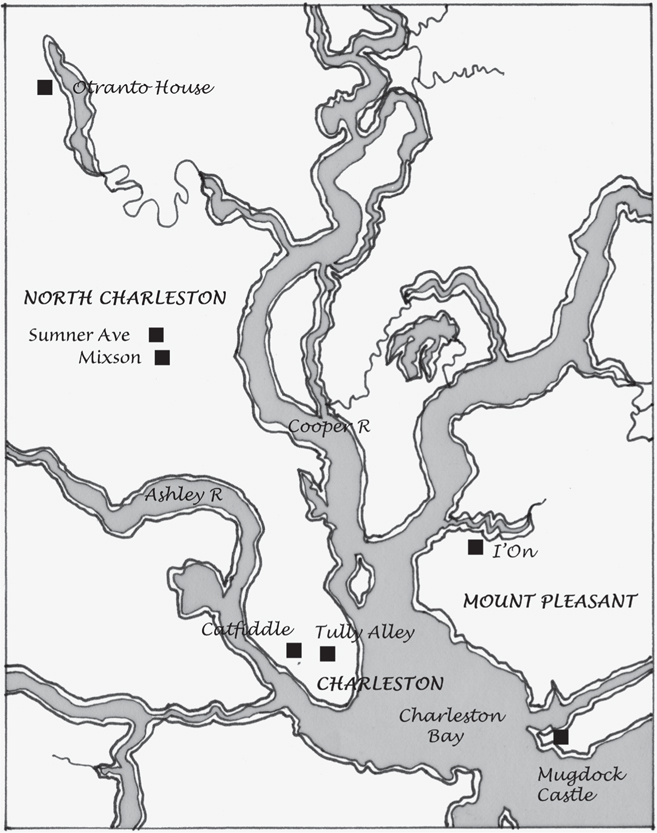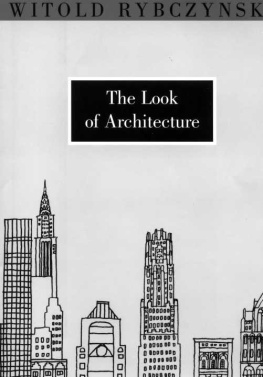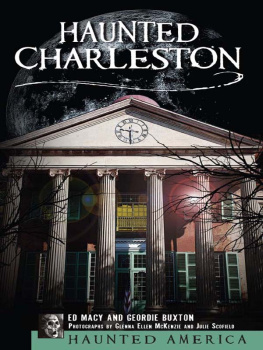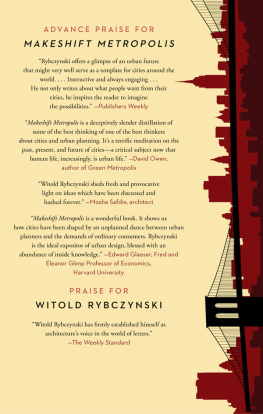C HARLESTON F ANCY
WITOLD RYBCZYNSKI
C HARLESTON F ANCY
Little Houses & Big Dreams in the Holy City

Copyright 2019 by Witold Rybczynski.
All rights reserved.
This book may not be reproduced, in whole or in part,
including illustrations, in any form (beyond that copying
permitted by Sections 107 and 108 of the U.S. Copyright Law
and except by reviewers for the public press), without written
permission from the publishers.
yalebooks.com/art
Set in Minion type by BW&A Books, Inc.
Library of Congress Control Number: 2018946045
ISBN 978-0-300-22907-3
eISBN 978-0-300-24383-3
A catalogue record for this book is available
from the British Library.
10 9 8 7 6 5 4 3 2 1
To Historic Renovations of Charleston,
New World Byzantine, Urban Ergonomics,
and little builders everywhere
Fancy noun (pl. fancies)
1 a feeling of liking or attraction.
2 the faculty of imagination.
3 (in sixteenth and seventeenth cent. music) a composition
for keyboard or strings in free or variation form.
New Oxford American Dictionary
Contents

Charleston and its environs
Introduction
C ities endure. Nine out of ten seventeenth-century Londoners lost their homes in the Great Fire, yet they rebuilt and the city pulled through; Berlin was devastated by the Second World War and divided during the Cold War, yet it stubbornly persevered; New Orleans was decimated by Hurricane Katrina, there was talk of moving the city, yet it stayed put and emerged smaller but unbowed. Men did not love Rome because she was great, observed the British essayist G. K. Chesterton. She was great because they had loved her. He meant that great cities are the result of deeply felt attachments, not merely practicalities. Go back to the darkest roots of civilization and you will find them knotted round some sacred stone or encircling some sacred well, he wrote. People first paid honor to a spot and afterwards gained glory for it.
Picking the right spot is important. When a group of British colonists arrived on the Carolina coast in April 1670, they first occupied an inland site on the western bank of a broad river. It proved an unhealthy location, and ten years later, they moved to a breezy peninsula at the rivers mouth. The cituation of this Town is so convenient for public Commerce that it rather seems to be the design of some skilfull Artist than the accidentall position of nature, wrote one of the settlers. There is a clean landing the whole length of the Town and also a most plesant prospect out to the Sea. The settlement grew, the landing was turned into a handsome esplanade, and Charles Town evolved into Charleston.
Many consider Charleston to be one of the most beautiful small cities in the United States. Its charm is elusive. There are no memorable public squares and few parks; the most prominent memorial is a column with a controversial statue of a dour John C. Calhoun, that ardent defender of slavery. There are some interesting old buildings, especially churches, but this is not a city of iconic monuments. Yet as you walk around
and this is a walkers paradisethe place grows on you. It is, above all, the everyday buildings that impress, less a matter of style than of human scale. Shaded verandas, or piazzas, as they are called locally, abound. Repetitive row houses, characteristic of northern cities, are absent. Instead, the typical Charleston house, the so-called single house, stands free with space around it, creating a lively streetscape and providing passersby with glimpses of green gardens and the ever-present palmettos.
The builders who createand preservea citys everyday fabric are as important as the founders and city fathers, for it is continuity that is the key to effective city building: the efforts of successive generations, using different means, pursuing different goals, perhaps even different dreams, but sharing an affection for the placeand for what has gone before. Everyday builders tend to stay in the background. The early history of architects in Charleston and its neighborhood consists largely of blanks, most of which can be filled only with question marks, wryly observed Beatrice St. Julien Ravenel, an early local historian. The origins of the ubiquitous single house, for example, remain murky. Questions such as who built the first one and when, whether it was a local invention or a Caribbean import, and why this useful model was not repeated elsewhere remain unanswered.
Art is a result, not a product, wrote Ralph Adams Cram, a leading American architect of the early 1900s, who makes more than one appearance in these pages. Buildings are the result of many things: of time and place, of regional culture, and even, to use a word no longer fashionable, of civilization. And of people. My Charleston story involves a group of present-day builders: a self-taught lover of Byzantine architecture, an Air Force pilot, a trained architect who is also an accomplished craftsman, a developer who calls himself a civic artist, and a bluegrass mandolin player who dreams of Palladio. A motley crew, brought together by circumstance, curiosity, friendship, and love of their adopted city. And by love of buildingall sorts of building: a bedecked Moorish house, an onion-domed Orthodox church, a spooky Victorian castle, and a latter-day medieval compound. My protagonists quirky approach to architecture and urbanism exhibits a kind of amateur mastery that runs against our cultural obsession with globe-trotting architect-for-hire expertise. Call it locatecture.
I remember the iconic closing line of a 1960s television police drama: There are eight million stories in the naked city. My narrative leans on vignettes rather than the big picture, on anecdotes rather than statistics, and on journalism rather than history. Yet it touches on several important questions: the challenges of renewing old neighborhoods, the art of creating brand-new places, the craft of building in an industrial age, the pros and cons of historic preservation, and the thorny question of architectural style. The answers demonstrate how living in a place affects people and how they in turn alter their surroundings; how an old city remakes itself by invention as well as replication; and how successful urban places are producedintricately, slowly, and lovingly, by individuals, one piece at a time.
All cities suffer periodic calamities, and Charleston has had more than its share: a naval bombardment during the Revolutionary War, a two-year Civil War siege, a disastrous conflagration, a catastrophic earthquake, regular floods, and periodic hurricanes that have left thousands homeless. So, its fitting that my story begins with a fire.
ONE
Georges House
The education of a master builder,
or how I learned to love Byzantine
Ten days before Christmas 2015, George Holts house burned down. A mutual friend e-mailed me a photograph: charred walls, scorched window frames, puddles of water on the floor. A pile of rubble filled the doorway of what had been the living roomit appeared that the roof had collapsed. I recognized a desk among the debris. The last time I had seen it, the surface had been covered with books and architectural drawings. Now it lay atop the pile with its cabriole legs sticking straight up into the air like a dead animal.
The painted surfaces of the wooden columns supporting an arcade in the atrium were blistered from the heat. Shafts of daylight streaked across the blackened walls. A marble bust that had stood on the windowsill lay in pieces on the flagstone floor, which was littered with broken glass. The sad scene had a curious poetry. It probably sounds strange, George e-mailed to me, but when emotions are set aside I find the remains of the principal rooms to be rather attractive. The great French architect Auguste Perret once observed,
Next page







